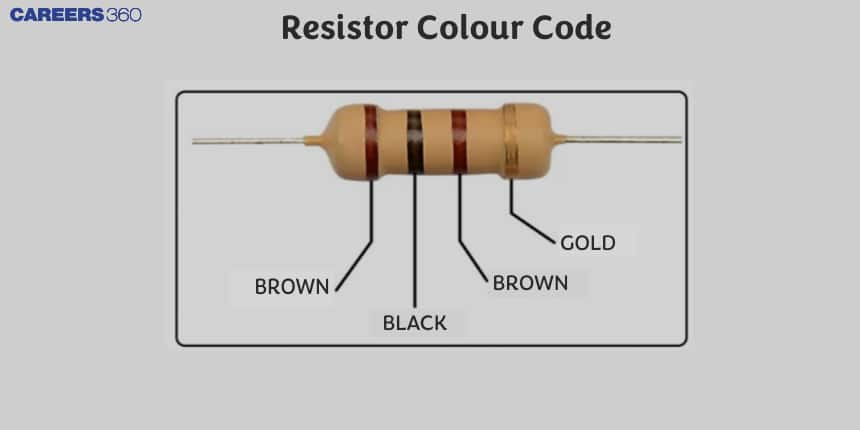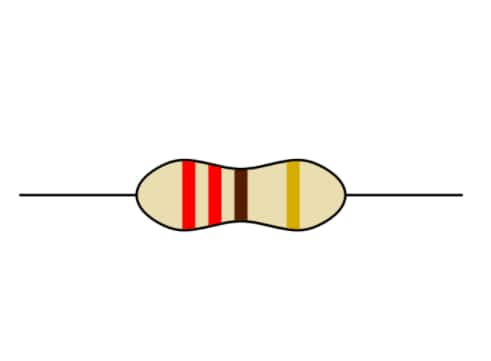Resistor Colour Code - Colour Chart, FAQs
In this article we are going to learn about resistor color codes ,resistance band , resistance value ,resistance band color code ,resistor color coding formula and examine the color code chart.
Resistor colour code :
In the electrical experiments resistances starting from about 0.1 ohm to 1000 ohm are widely used .These types of resistances are generally made of copper or any other conducting metal or alloys .Usually in electronics goods resistances are less than 1000 ohm. Nowadays , high resistances graphite and gas carbon are used widely .These resistors are known as carbon resistor. The allotropes of carbon are thousand times greater than metals .Carbon is very effective as an element of high resistance .The carbon resistors are cheaper than metal resistors.
JEE Main/NEET 2027: Physics Important Formulas for Class 10
NEET 2025: Mock Test Series | Syllabus | High Scoring Topics | PYQs
JEE Main: Study Materials | High Scoring Topics | Preparation Guide
JEE Main: Syllabus | Sample Papers | Mock Tests | PYQs
- Resistor colour code :
- Resistance Colour code chart :
- Reading of a resistor color code :


Color code of carbon resistor
A cylindrical shell of bad conductor is used to made carbon resistor .The value of resistance can be determined by calculating the color codes drawn on the resistance .Two conducting metal wires are taken out from either side of the shell along its axis through which the resistor is connected to the external circuit .The fourth color is drawn apart from the three consecutive colors .From the above diagram we can see that the yellow color is apart from the two red and brown color .From the colors of the resistor we can calculate the resistance of the resistor .
Also read -
- NCERT Solutions for Class 11 Physics
- NCERT Solutions for Class 12 Physics
- NCERT Solutions for All Subjects
Resistance Colour code chart :
Resistance colour code chart or resistor color code calculator are used to calculate the resistance and tolerance values of resistors.
There are 10 signal digits from 0 to 9 which corresponds to 10 colors.


As shown in the table, different colours represent different values in the resistor colour code. The gold colour code is the multiplier to the resistance value. Black colour code is 0, brown colour code is 1, red colour code is 2, orange colour code is 3, yellow colour code is 4, green colour code is 5 and so on. It is the resistor color code calculator
Related Topics Link, |
Also Read:
- NCERT solutions for Class 12 Physics Chapter 3 Current Electricity
- NCERT Exemplar Class 12 Physics Solutions Chapter 3 Current Electricity
- NCERT notes Class 12 Physics Chapter 3 Current Electricity
Reading of a resistor color code :
According to the given diagram of the resistor
Red blue violet gold
For red and blue we will put the values of the digit , for violet we will write multiplier and for gold we will write tolerance.
Red colour code is 2
For blue digit is 6
For violet digit is 7 so the multiplier is 107
For gold the tolerance is ±5%
So the resistance of the given resistor Red blue violet gold will be (26×107) ±5% Ω
How to remember the sequence of the color code :
To remember the color code sequence of color code given above by the sentence given below,
B B ROY of Great Britain has a Very Good Wife wearing Gold and Silver necklace.
Tolerance:
Tolerance is the product of the value of the resistor and the tolerance band value .
Also check-
- NCERT Exemplar Class 11th Physics Solutions
- NCERT Exemplar Class 12th Physics Solutions
- NCERT Exemplar Solutions for All Subjects
NCERT Physics Notes:
Frequently Asked Questions (FAQs)
Radio Manufacturers Association (RMA) invented resistor colour code.
In the 1920s the resistor colour code was invented.
Resistors are small. In such a small space, it is hard to write the values of the resistors so resistors are colour-coded.
Brown, Black and brown and gold (as tolerance factor) will be the resistor code of 100 Ω.
Carbon resistors are used most commonly than metal resistors because they are cheaper than metal resistors. Also, they are smaller in size so carbon resistor colour codes can be easily analyzed.
As reported by wire colour code India, the red colour signifies live power, the black colour indicates neutral and the green colour shows the earthing.
Also Read
29 Nov'24 09:48 AM
23 Nov'24 01:56 PM
20 Nov'24 10:32 AM
17 Nov'24 10:02 AM
17 Nov'24 09:56 AM
14 Nov'24 07:31 PM
14 Nov'24 05:59 PM
14 Nov'24 01:16 PM
14 Nov'24 12:54 PM


